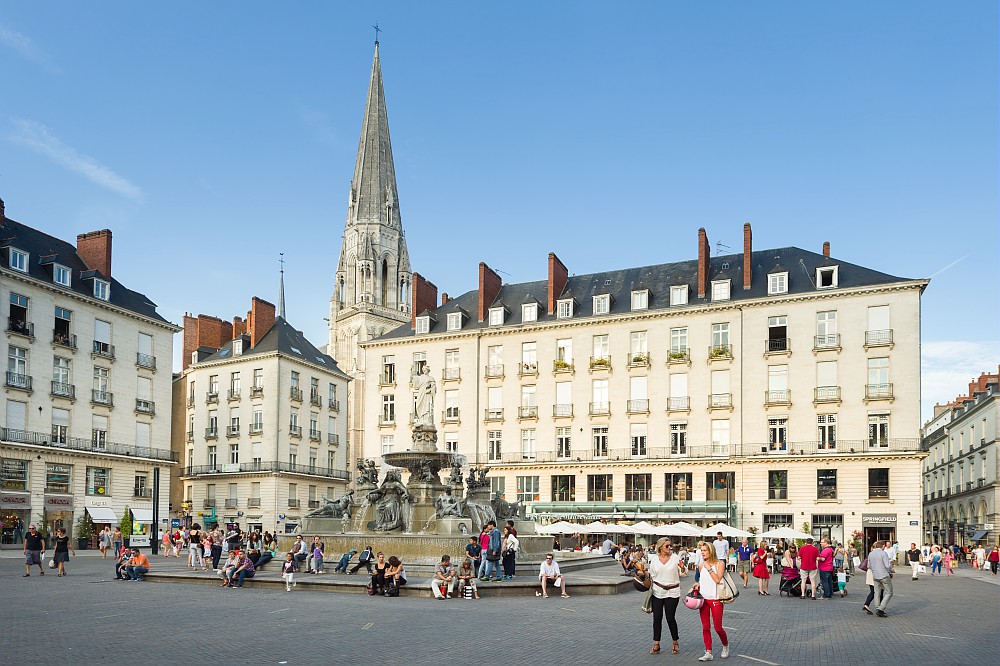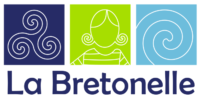
Walking through Nantes, it becomes clear why the Bretons still mourn their former capital. For centuries, Nantes was the seat of the dukes and kings of Brittany. After losing its independence, Nantes continued to flourish and rose to become one of the most important port cities on the French Atlantic coast. Today, magnificent buildings bear witness to the rich history of the city, which still remains unmistakably Breton in some corners of its heart.
Discover now:
Places Of Interest
The walk through Nantes begins on the north side of the main railway station. On the opposite side is the Jardin des Plantes, a beautiful park. Some of the plants have been trimmed into works of art. For example, you’ll find a giant sleeping cat made of hedges or a grinning seal. Great fun, especially for the kids!
In the northwest corner, one of the park’s main paths leads onto Rue Georges Clemenceau, where the Musée des Beaux Arts appears after a few metres. Only a detour doesn’t do the museum justice. You should plan half a day to visit the exhibitions, the collections are too extensive, from classical paintings to modern objects. The next highlight is hidden at the end of Rue Georges Clemenceau.
The Castle Of The Dukes Of Brittany
Nantes Cathedral remains hidden behind trees, however, as you turn left along the Cours Saint-Pierre. The wide avenue leads to a staircase from whose steps the castle of the Dukes of Brittany is visible. From within the walls, whose origins date back to the 13th century, symbols of Breton independence such as Anne de Bretagne ruled over the north-west. The “Château des ducs de Bretagne” is therefore not only considered one of the heart chambers of Nantes, but is historically an important centre of Brittany.
Parts of the castle, such as the courtyard or the castle walls on the south-western side, are freely accessible, while others house exhibitions for which a fee is charged. The castle, the moat and the surrounding green spaces are excellently maintained. A nice place for a picnic – even though the castle is a top tourist attraction and of course always very busy.
Continue along the narrow Rue Mathelin Rodier in the northwest corner of the square area around the castle. The street leads to Place Saint-Pierre. This is where the “Petit train des Nantes” departs. For those who find the walk through the city too long, the motorised road train offers a convenient alternative. The “Petit train” looks downright tiny next to Nantes Cathedral, whose main entrance is on the square. The late Gothic Cathédrale Saint-Pierre-et-Saint-Paul is considered in art history to be one of the most remarkable in France in several respects, among others because of its vault height of 38 metres.
Japanese Garden And The Market Halls Of The Marché Talensac
After a possible flying visit to the church, a deviation from our walk / stroll could be on the agenda. Via Rue de l’Évêché and Rue Sully, we reach the Erdre, one of the two large rivers that join the Loire at Nantes. After a short walk along the river bank, a bridge spans the artificial Île de Versailles in the middle of the river. What makes the Île de Versailles special is the Japanese Garden. Exotic plants thrive here in elaborate gardens.
If you forgo the Japanese Garden at the Cathédrale de Nantes, leave Place Saint-Pierre in a westerly direction via Rue du Général-Leclerc-de-Hauteclocque and then turn right at the first opportunity into Rue de Strasbourg. Follow the road past the Town Hall and the Prefecture until you reach the Monument to Charles de Gaulle.
After the statue, the street becomes Rue Paul Bellamy. After a few metres, you will see the Marché Talensac. The market hall leaves nothing to be desired: Wine from the Loire region, cheese and meat specialities, fresh seafood and fish from Brittany, fruit and vegetables that bend the displays – everything for sale or prepared by the gastronomes in the bistros.
The next stop, Place Viarme, is reached by leaving the Marché Talensac at the southwest corner via Rue Auguste Brizeux and turning left at its end into Rue Fredureau. On Place Viarme, the tram tracks are not to be missed. Follow the tracks towards the city centre (south). After some walking, the “Tour de Bretagne” skyscraper, one of the tallest office buildings in France outside Paris, catches your eye.
Place du Bouffay
Leave the Tour Bretagne behind. At the “Commerce” tram stop on the busy Cours de 50 Otages, Rue de Viel Hôpital leads onto Rue du Bouffay, which in turn leads onto Place du Bouffay. Even if you no longer see it in the architectural ensemble: The square is one of the oldest parts of Nantes, and just behind the Place is the castle of the Dukes of Brittany. Today, large open-air artworks stand in the square and a host of restaurants and shops line the Bouffay and surrounding streets.
At the north-east corner, continue along Rue de la Baclerie. On the next corner, the walker comes across the Église Sainte-Croix, a small church that could be anywhere in Brittany. Continue along the road until you reach a pedestrian zone. Turn left here, the street is first called Rue de la Marne, then becomes Rue de la Barrillerie and finally Rue d’Orléans until Place Royale. Place Royale is the site of the Nantes Christmas market during Advent. This district is lively all year round, not least because one of Nantes’ greatest sights is close by.
Passage Pommeraye
Turn from Place Royale onto Rue de la Fosse and you will see the entrance to Passage Pommeraye after just a few metres. This “shopping mall”, built in 1843, is rich in architectural details on 3 floors. Columns, sculptures, ceiling ornaments and stucco reliefs – depending on the occasion, shopping becomes a minor matter or an exclusive experience. In the midst of all this splendour, you feel as if you are in Paris (which was probably also the aim of the builders of the Passage Pommeraye).
Leaving the passage on rue Santeuil, you have climbed a height difference of almost 10 metres via the various staircases. Turning right, you come to rue Crébillon, which after a short while leads to Place Graslin. The square is famous for the “Théâtre Graslin”, an opera building with imposing Greco-Roman style columns, the fountain and the brasserie “La Cigale”, whose façade is designed in the Art Noveau style.
Leave the square via Rue Piron and shortly afterwards turn right into the Cours Cambronne green space. Another monument meets the walker through Nantes, the eponymous General Cambronne, a native “Nantais”, is venerated here.
The main path leads directly onto Rue Maurice Sibille. Follow this road to Rue Flandres – Dunkerque and turn left at the crossroads. The Loire is now already in sight, on the Quai de la Fosse (turn right), follow the watercourse called “Liger” in Breton to the Pont Anne de Bretagne bridge.
Les Machines de l’île
On the other side of the Loire, you enter the Île de Nantes. On the island lies the exhibition site “Les Machines de l’île”, one of Nantes’ most unusual sights. Creative engineers have created imaginative creatures in a former warehouse of the port and brought them to life. As a mixture between sculpture and interactive carousel, you can imagine objects such as a giant spider, a crane or the highlight of the project, the 12-metre-high elephant. The creatures are inspired by drawings by Leonardo da Vinci and the novels of Jules Verne, perhaps the most famous son of the city of Nantes. Especially for children, the demonstrations and rides with the animals are an unforgettable experience.
The other sights of the Île de Nantes are quickly enumerated: a huge crane as part of the harbour complex as well as the “Anneaux de Buren”, illuminated steel rings by an artist, which have their best effect in the evening and at night and which. If you want to forgo these attractions, return directly to the actual part of Nantes via the Anne de Bretagne bridge. Here, take the Quai de la Fosse, which later becomes Rue Gaston Michel and still later Quai André Morice.
Conclusion Of The Walk At The Tour LU
At Avenue Jean Claude Bonduelle, the path turns left, straight towards the last sight of Nantes on our tour. The “Tour LU” tower is considered one of the city’s landmarks because of its oriental appearance. Originally, the buildings around the tower housed the LU brand biscuit bakeries. Today the “Lieu unique”, the “unique place”, is the venue for events and concerts.
Opposite the tower, the castle of Nantes is already visible and our route comes full circle. At the latest now you have earned some refreshment. How about one of the culinary specialities of Nantes? Inspired by the last stop at the Tour LU: in the cafés, you’re sure to find sweet specialities such as the sponge cake “Le petit mouzillon” or a piece of “Gâteau nantais”. If you prefer something savoury first, how about “Canard de Challans”, duck with potatoes and a sauce made from Muscadet, the wine of the Nantes region. Enjoy your meal!
Weather
Perhaps the decision to detach Nantes from Brittany was also made because the weather here is so atypical for the far northwest. Joking aside, the fact is that Nantes is climatically closer to Bordeaux than Brest. The comparison shows how much milder it is at the mouth of the Loire.
Sunshine hours per year: 1,954 days in Nantes, 1,749 days in Brest
Rainfall: 788 mm in Nantes, 1,109 mm in Brest
Average maximum temperature over the whole year: 16.1° C in Nantes, 14.1° C in Brest
The most popular time to visit is in June, July and August, when temperatures range between 20 and 25° C in fine weather. Even if it should be hot, a light breeze still reaches the centre of Nantes from the nearby sea.
Eating & Drinking In Nantes
The gastronomy is as varied and lively as Nantes itself. The selection of restaurants presented here is therefore not limited to establishments serving French cuisine.
L’Instinct Gourmand
Guide Michelin praises L’Instinct Gourmand at 14 rue Saint-Léonard as an insider tip. The chefs have won the laurels of the gourmet experts for creative French cuisine. A lunch menu costs between EUR 11.90 and EUR 16.90. It gets a little more expensive, but also more varied, in the evening, when a dish costs around 20 EUR.http://www.linstinctgourmand.com/
Cour:87
Cour:87 is hip: floorboards, unplastered walls and the ceiling of the restaurant is covered with sketches, with Miles Davis spinning on the turntable. The menu includes, for example, a pan of prawns, candied duck or Muscadet sausages. Sounds delicious and is affordable. Let’s go to 77 Rue Maréchal Joffre!
À la Belle Cocotte
This restaurant specialises in dishes from the saucepan. Visitors praise the original oven dishes with poultry, chorizo, rice and coriander or duck, pineapple, cashew and sweet potato. À la Belle Cocotte is located in the heart of Nantes at 6 rue Cacault.
http://www.alabellecocotte.fr/
Le Rout’Art Gourmand
Not in the mood for French cuisine today? The best burger joint in Nantes is located on Chemin du Vigneau, just outside the centre. The team knows how to give a special touch to a speciality as un-French as the burger, with a lot of finesse. The menu also includes dishes that are popular all over the world, such as polenta, steak and gaspacho.
http://www.leroutartgourmand.com/
Images: Comité Régional du Tourisme de Bretagne | © Yanick Le Gal, © Emmanuel Berthier
